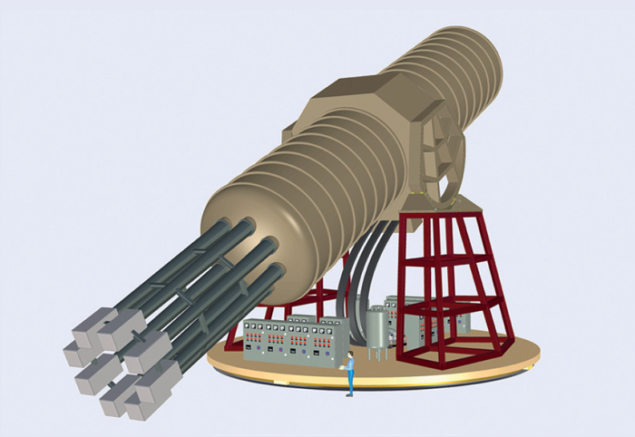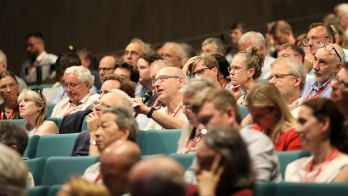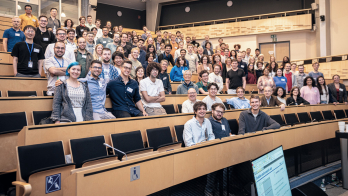A large superconducting magnet could cast light on the dark universe.

Image credit: CERN.
The recent discovery of a Higgs boson at CERN appears to represent the summit in the successful experimental verification of the Standard Model of particle physics. However, although essentially all of the data from particle accelerators are so far in perfect agreement with the model’s predictions, a number of important theoretical and observational considerations point to the necessity of physics beyond the Standard Model. An especially powerful argument comes from cosmology. The currently accepted cosmological model invokes two exotic ingredients – dark matter and dark energy – which pervade the universe. In particular, the observational evidence for dark matter (via its gravitational effects on visible matter) is now overwhelming, even though the particle-physics nature of both dark matter and dark energy remains a mystery.
At the same time, the theoretical foundations of the Standard Model have shortcomings that prompt theorists to propose and explore hypothetical ways to extend it. Supersymmetry is one such hypothesis, which also naturally provides particles as candidates for dark matter, known as weakly interacting massive particles (WIMPs). Other extensions to the Standard Model predict particles that could lie hidden at the low-energy frontier, of which the axion is the prototype. The fact that supersymmetry has not yet been observed at the LHC, and that no clear signal of WIMPs has appeared in dark-matter experiments, has increased the community’s interest in searching for axions. However, there are independent and powerful motivations for axions, and dark matter composed of both WIMPs and axions is viable, implying that they should not be considered as alternative, exclusive solutions to the same problem.
After more than a decade of searching for solar axions, CAST has put the strongest limits yet on axion–photon coupling
Axions appear in Standard Model extensions that include the Peccei–Quinn mechanism, which provides the most promising solution so far to one of the problems of the Standard Model: why do strong interactions seem not to violate charge–parity symmetry, while according to QCD, the standard theory of strong interactions, they should do? Unlike many particles predicted by theories that go beyond the Standard Model, axions should be light, and it might seem that they should have been detected already. Nevertheless, they could exist and remain unnoticed because they naturally couple only weakly with Standard Model particles.
A generic property of axions is that they couple with photons in a way that axion–photon conversion (and vice versa) can occur in the presence of strong magnetic or electric fields. This phenomenon is the basis of axion production in the stars, as well as of most strategies for detecting axions. Magnets are therefore at the core of any axion experiment, as is the case for axion helioscopes, which look for axions from the Sun. This is the strategy followed by the CERN Axion Solar Telescope (CAST), which uses a decommissioned LHC test magnet (CERN Courier April 2010 p22). After more than a decade of searching for solar axions, CAST has put the strongest limits yet on axion–photon coupling across a range of axion masses, surpassing previous astrophysical limits for the first time and probing relevant axion models of sub-electron-volt mass. However, to improve these results and go deep into unexplored axion parameter space requires a completely new experiment.
The International Axion Observatory (IAXO) aims for a signal-to-noise ratio 105 better than CAST. Such an improvement is possible only by building a large magnet, together with optics and detectors that optimize the axion helioscope’s figure of merit, while building on experience and concepts of the pioneering CAST project.

Image credits: U de Zaragoza/CAST and Todd Decker/LLNL, respectively.
The central component of IAXO is a superconducting toroid magnet. The detector relies on a high magnetic field distributed across a large volume to convert solar axions to detectable X-ray photons. The magnet’s figure of merit is proportional to the square of the product of magnetic field and length, multiplied by the cross-sectional area filled with the magnetic field. This consideration leads to a 25-m-long and 5.2-m-diameter toroid assembled from eight coils, generating 2.5 T in eight bores of 600 mm diameter, thereby having a figure of merit that is 300 times better than the CAST magnet. The toroid’s stored energy is 500 MJ.
The design is inspired by the barrel and endcap toroids of the ATLAS experiment at the LHC, which has the largest superconducting toroids ever built and currently in operation at CERN. The superconductor used is a NbTi/Cu-based Rutherford cable co-extruded with aluminum – a successful technology common to most modern detector magnets. The IAXO detector needs to track the Sun for the longest possible period, so to allow rotation around the two axes, the 250-tonne magnet is supported at its centre of mass by a system used for large telescopes (figure 1). The necessary services for vacuum, helium supply, current and controls rotate together with the magnet.
Each of the eight magnet bores will be equipped with X-ray focusing optics that rely on the fact that at X-ray energies the index of refraction is less than unity for most materials. By working at shallow (or grazing) incident angles, it is possible to make mirrors with high reflectivity. Mirrors are commonly used at synchrotrons and free-electron lasers to condition or focus the intense X-ray beams for user experiments, but IAXO requires optics with much larger apertures. For nearly 50 years, the X-ray astronomy and astrophysics community has been building telescopes following the design principle of Hans Wolter, employing two conic-shaped mirrors to provide true-imaging optics. This class of optics allows “nesting” – that is, placing concentric co-focal X-ray mirrors inside one another to achieve high throughput.
IAXO will use CERN’s expertise efficiently to venture deep into unexplored axion parameter space
The IAXO collaboration envisions using optics similar to those used on NASA’s NuSTAR – an X-ray astrophysics satellite with two focusing telescopes that operate in the 3–79 keV band. NuSTAR’s optics consist of thousands of thermally formed glass substrates deposited with multilayer coatings to enhance the reflectivity above 10 keV (figure 2). For IAXO, the multilayer coatings will be designed to match the softer 1–10 keV solar-axion spectrum.
At the focal plane in each of the optics, IAXO will have small time-projection chambers read by pixelized planes of Micromegas. These detectors (figure 2) have been developed extensively within the CAST collaboration and show promise for detecting X-rays with a record background level of 10–8–10–7 counts/keV/cm2/s. This is achieved by the use of radiopure detector components, appropriate shielding, and offline discrimination algorithms on the 3D event topology in the gas registered by the pixelized read-out.
Beyond the baseline described above, additional enhancements are being considered to explore extensions of the physics case for IAXO. Because a high magnetic field in a large volume is an essential component in any axion experiment, IAXO could evolve into a generic “axion facility” and facilitate various detection techniques. Most intriguing is the possibility of hosting microwave cavities and antennas to search for dark-matter axions in mass ranges that are complementary to those in previous searches.
The growing IAXO collaboration has recently finished the conceptual design of the experiment, and last year a Letter of Intent was submitted to the SPS and PS Experiments Committee of CERN. The committee acknowledged the physics goals of IAXO and recommended proceeding with the next stage – the creation of the Technical Design Report. These are the first steps towards the realization of the most ambitious axion experiment so far.
After more than three decades, the axion hypothesis remains one of the most compelling portals to new physics beyond the Standard Model, and must be considered seriously. IAXO will use CERN’s expertise efficiently to venture deep into unexplored axion parameter space. Complementing the successful high-energy frontier at the LHC, the IAXO facility would open a new window on the dark universe.








